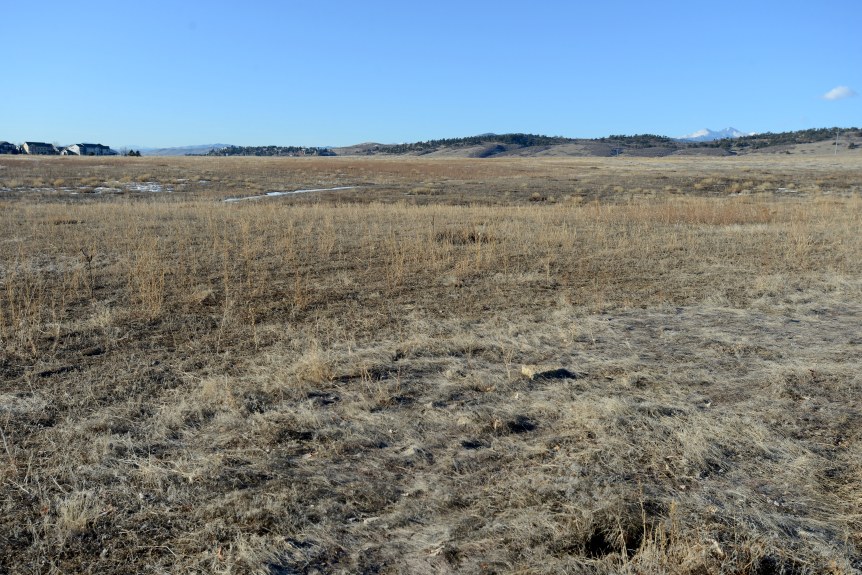LOVELAND, CO – Jan. 14, 2020: A portion of the 245-acre Lee Farm property is seen Tuesday looking southwest from the Buckhorn Village neighborhood in northwest Loveland. The new owner of the land is reviving plans to build approximately 900 homes over the next several years in the parcel west of Wilson Avenue and north of 35th Street. Some homes in the Hunters Run subdivision can be seen in the distance at left. (Craig Young / Loveland Reporter-Herald)
Subdivision would have about 900 homes; other projects could follow.
The new owner of the 245-acre Lee Farm property in northwest Loveland is reviving plans to build 900 homes, coordinating with other developers to build a water pump station that could unlock the development of 2,000 to 3,000 homes in the area.
Last month, Phoenix-based Walton Global Holdings Ltd. purchased the parcel west of Wilson Avenue and north of 35th Street that had been annexed into the city in 2006 but never developed. According to Larimer County property records, Walton paid $4 million for the land.
Walton is negotiating with a publicly traded national homebuilder to begin development of the property this year or early in 2021, according to Barry Dluzen, senior vice president of land acquisitions for Walton.
A previous owner already gained city approval to build a mix of housing on the land, said Brett Limbaugh, Loveland’s development services director.
“For the most part, they can get underway fairly quickly,” he said, adding that the new owner has the option to make amendments to the general development plan, which already was amended in 2016 by a previous owner.
The plans allow single-family homes on lots of varying size, patio homes, duplexes and condominiums, according to city documents, with the higher-density uses built closest to Wilson Avenue and the neighborhood becoming less dense to the west.
“There are mixes on all of these products,” Limbaugh said. “That’s what we would encourage, too. We really want to provide a wide spectrum of price points.”
Kate Kaminski, chief operating officer of Walton, said the builder or builders will be the ones to make specific decisions on the type and mix of homes constructed in the subdivision.
Dluzen said the houses would sell in the $300,000 to $400,000 range.
If the infrastructure is started late this year, the first houses could be available in 2023, with eventual build-out completed by 2028, he said.
One aspect of the infrastructure still needs to be worked out before the neighborhood can be fully built, according to Troy Bliss, senior planner with the city of Loveland.
The western, higher-elevation side of the parcel is designated with a lower water pressure, which means a pump station needs to be built to provide water to those future homes, he said.
The new facility would be constructed next to an existing city pump station at the west end of 29th Street next to Mehaffey Park, he said.
Because of the cost of the station, which wasn’t available, the city has gathered all the owners of potential developments together to discuss how the infrastructure could be jointly funded in a fair manner, Bliss said.
“That’s one of the challenges we’ve been trying to get off dead center, to get this part of the community active in terms of development,” he said.
If all the undeveloped properties in the area take advantage of the increased water pressure, it could result in 2,000 to 3,000 more homes once the developments are built out, Bliss said.
Walton Global Holdings
The Lee Farm property in northwest Loveland, seen in green at upper left, has a new owner, which intends to go ahead with previously approved plans to build approximately 900 homes over the next eight years.
Walton, which has been buying and selling land for development in the United States and Canada for 40 years, recently changed its acquisition strategy, Kaminski said.
The company and its “patient” investors identify properties, find builders to develop them and enter into “exit focused agreements” with the builders, then buy the land and hold it until the builders are ready to start. The builders then purchase lots as they build homes and sell them.
“We’re essentially banking the land for them,” Kaminski said.
Another example of a property that Walton is working to find a builder for is a field off the east side of Berthoud’s First Street just north of town, which bears a sign that says “Mountain View: Another future Walton community.”
Dluzen and Kaminski said they expect to have an agreement in place with a builder for that parcel before next summer. The land would have to be zoned and annexed into Berthoud, so initial infrastructure wouldn’t start until 2021 or 2022, Dluzen said.



